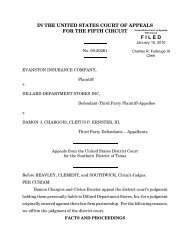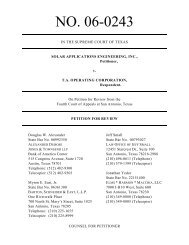Laughlin v. Nouveau Body & Tan - The Appellate Record
Laughlin v. Nouveau Body & Tan - The Appellate Record
Laughlin v. Nouveau Body & Tan - The Appellate Record
You also want an ePaper? Increase the reach of your titles
YUMPU automatically turns print PDFs into web optimized ePapers that Google loves.
Case: 09-10622 Document: 00511064454 Page: 18 Date Filed: 03/29/2010No. 09-10622the oblique action, the creditor exercises a right belonging to the debtor in thedebtor’s name. In the revocatory action, the creditor acts in his own name toenforce his own rights. . . . We construe the [renunciation annulment action tobe] a revocatory action.”) (citations omitted; emphasis added).13<strong>The</strong>sestatements reinforce the notion that article 967 does not recognize or createrights in the renouncing successor.Third, the procedure of the article 967 action does not disturb ourinterpretation of article 967. Louisiana courts require that the creditor whoseeks an annulment petition the court to reopen the succession. See Neuhauser,579 So. 2d at 439 (“[<strong>The</strong> creditor] petitioned the court to reopen the successionof the [decedent] alleging that the creditor was a judgment creditor of the[renouncing successor].”); id. at 442 (“‘When the creditors wish to be authorizedto accept a succession, which their debtor . . . has renounced to their prejudice,they must present a petition to the judge of the place where the succession isopened . . . .’” (quoting former article 1071)); Succession of Wagner, 746 So. 2d696, 697 (La. Ct. App. 1999) (creditor “filed petitions to annul [successor’s]renunciation” in trial court and the trial court annulled the renunciation,13<strong>The</strong> Louisiana Supreme Court has also analogized the renunciation annulment actionto a “revocatory action” under article 2036 of the Louisiana Civil Code. See Neuhauser, 579So. 2d at 440; D.A. Pearce–Reggio, Note, Succession of Neuhauser: Death of a Creditor’sClaim, 66 TUL. L. REV. 1101, 1109 (1992) (“[T]he [Louisiana Supreme C]ourt adhered to theprevailing view that an action to annul a debtor’s renunciation falls within the ambit of therevocatory action.”); see also LA. CIV. CODE ANN. art. 2036 (“An obligee has a right to annul anact of the obligor, or the result of a failure to act of the obligor, made or effected after the rightof the obligee arose, that causes or increases the obligor’s insolvency.”). And we have notedthat “under Louisiana and federal bankruptcy law, the trustee may avoid [a debtor]’s transfers. . . by stepping into the shoes of a[ ] . . . creditor who could have avoided those transfers bymeans of a revocatory action.” Traina v. Whitney Nat’l Bank, 109 F.3d 244, 246 (5th Cir. 1997)(emphasis added). We derived this authority from § 544(b) of the bankruptcy code whichstates that a “trustee may avoid any transfer of an interest of the debtor in property or anyobligation incurred by the debtor that is voidable under applicable law by a creditor holdingan unsecured claim.” 11 U.S.C. § 544(b)(1). Given the posture of the present case, however,we need not consider whether the trustee has the power under § 544(b)(1) to bring an article967 action.18




